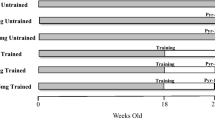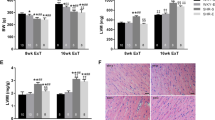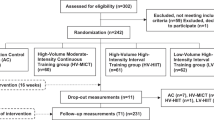Abstract
The treatment of hypertensive patients with losartan is very common. Despite the reduction in blood pressure, its effects on cardiac contractility and sympathetic autonomic drive are still controversial. In turn, aerobic physical training (APT) also presents an important therapeutic option, providing significant improvements in cardiovascular autonomic control, however little is known about its effects on cardiac contractility, especially when associated with losartan. Therefore, we investigated in spontaneously hypertensive rats (SHR) the effects of losartan and APT on cardiac hemodynamics and functionality, with emphasis on autonomic tonic balance and cardiac contractility. Sixty-four SHR (18 weeks old) were divided into four groups (N = 16): vehicle; vehicle submitted to APT through swimming for 12 weeks; treated with losartan (5 mg·kg−1·d−1) for 12 weeks; and treated with losartan associated with APT. The groups were submitted to cardiac morphological and functional analysis by echocardiography; double blockade of cardiac autonomic receptors with atropine and propranolol; and coronary bed reactivity and left ventricular contractility analyses by the Langendorff technique. APT improved functional parameters and autonomic balance by reducing sympathetic drive and/or increasing vagal drive. In contrast, it promoted a concentric remodeling of the left ventricle (LV). Treatment with losartan reduced sympathetic autonomic drive and cardiac morphological parameters, but there were no significant gains in cardiac functionality and contractility. When combined, the concentric remodeling of the LV to APT was abolished and gains in cardiac functionality and contractility were observed. Our findings suggest that the effects of losartan and APT are complementary and should be applied together in the treatment of hypertension.

In spontaneously hypertensive rats, the combination of aerobic physical training with losartan treatment was crucial to greater blood pressure reductions and an increase in left ventricular contractility. Furthermore, losartan treatment prevented the concentric left ventricular remodeling caused by aerobic physical training.
This is a preview of subscription content, access via your institution
Access options
Subscribe to this journal
Receive 12 print issues and online access
$259.00 per year
only $21.58 per issue
Buy this article
- Purchase on Springer Link
- Instant access to full article PDF
Prices may be subject to local taxes which are calculated during checkout




Similar content being viewed by others
References
Smith TL, Hutchins PM. Central hemodynamics in the developmental stage of spontaneous hypertension in the unanesthetized rat. Hypertension. 1979;1:508–17.
Dornas WC, Silva ME. Animal models for the study of arterial hypertension. J Biosci. 2011;36:731–7.
Masson GS, Michelini LC. Autonomic dysfunction, sympathetic hyperactivity and the development of end-organ damage in hypertension: multiple benefits of exercise training. Hear Res Open J. 2015;2:60–9.
Shanks J, Manou-Stathopoulou S, Lu CJ, Li D, Paterson DJ, Herring N. Cardiac sympathetic dysfunction in the prehypertensive spontaneously hypertensive rat. Am J Physiol Hear Circ Physiol. 2013;305:980–6.
Williams B, Mancia G, Spiering W, Rosei EA, AZIZI M, Burnier M, et al. 2018 ESC/ESH Guidelines for the management of arterial hypertension: The Task Force for the Management of Arterial Hypertension of the European Society of Cardiology (ESC) and the European Society of Hypertension (ESH). Eur Heart J. 2018;39:3021–104.
Da Costa Rebelo RM, Schreckenberg R, Schlüter KD. Adverse cardiac remodelling in spontaneously hypertensive rats: acceleration by high aerobic exercise intensity. J Physiol. 2012;590:5389–400.
Schultz RL, Swallow JG, Waters RP, Kuzman JA, Redetzke RA, Said S, et al. Effects of excessive long-term exercise on cardiac function and myocyte remodeling in hypertensive heart failure rats. Hypertension. 2007;50:410–6. https://www.ahajournals.org/doi/10.1161/HYPERTENSIONAHA.106.086371.
Vieira S, Aguilar BA, Veiga AC, Philbois SV, Freitas ACS, Rodrigues KP, et al. Integrative physiological study of adaptations induced by aerobic physical training in hypertensive hearts. Front Physiol. 2022;13:1–10.
Choi SY. The characteristics of electrocardiography findings in left ventricular remodeling patterns of hypertensive patients. Biomed Sci Lett. 2015;21:208–17.
Pagan LU, Damatto RL, Gomes MJ, Lima ARR, Cezar MDM, Damatto FC, et al. Low-intensity aerobic exercise improves cardiac remodelling of adult spontaneously hypertensive rats. J Cell Mol Med. 2019;23:6504–7.
Kemi O, Haram P, Loennechen J, Osnes J, Skomedal T, Wisloff U, et al. Moderate vs. high exercise intensity: differential effects on aerobic fitness, cardiomyocyte contractility, and endothelial function. Cardiovasc Res. 2005;67:161–72. https://academic.oup.com/cardiovascres/article-lookup/doi/10.1016/j.cardiores.2005.03.010.
Unger T, Borghi C, Charchar F, Khan NA, Poulter NR, Prabhakaran D, et al. 2020 International Society of Hypertension Global Hypertension Practice Guidelines. Hypertension. 2020;75:1334–57.
Al-Majed ARA, Assiri E, Khalil NY, Abdel-Aziz HA. Losartan: comprehensive profile. Profiles Drug Subst Excip Relat Methodol. 2015;40:159–94.
Maida KD, Gastaldi AC, de Paula Facioli T, de Araújo JE, de Souza HC. Physical training associated with enalapril but not to losartan, results in better cardiovascular autonomic effects. Auton Neurosci Basic Clin. 2017;203:33–40. https://doi.org/10.1016/j.autneu.2016.12.002.
Mowry FE, Peaden SC, Stern JE, Biancardi VC. TLR4 and AT1R mediate blood-brain barrier disruption, neuroinflammation, and autonomic dysfunction in spontaneously hypertensive rats. Pharm Res. 2021;174:105877 https://doi.org/10.1016/j.phrs.2021.105877.
Biancardi VC, Son SJ, Ahmadi S, Filosa JA, Stern JE. Circulating angiotensin II gains access to the hypothalamus and brain stem during hypertension via breakdown of the blood-brain barrier. Hypertension. 2014;63:572–9.
Nunez E, Hosoya K, Susic D, Frohlich ED. Enalapril and losartan reduced cardiac mass and improved coronary hemodynamics in SHR. Hypertension. 1997;29:519–24.
Biancardi VC, Stern JE. Compromised blood-brain barrier permeability: Novel mechanism by which circulating angiotensin II signals to sympathoexcitatory centres during hypertension. J Physiol. 2016;594:1591–600.
Tomaz de Castro QJ, Araujo CM, Watai PY, de Castro e Silva SS, de Lima WG, Becker LK, et al. Effects of physical exercise combined with captopril or losartan on left ventricular hypertrophy of hypertensive rats. Clin Exp Hypertens. 2021;43:536–49. https://doi.org/10.1080/10641963.2021.1907399.
Gardim CB, Veiga AC, Aguilar BA, Philbois SV, Souza HCD. Effects of chronic cholinergic stimulation associated with aerobic physical training on cardiac morphofunctional and autonomic parameters in spontaneously hypertensive rats. Sci Rep. 2021;11:1–10. https://doi.org/10.1038/s41598-021-96505-2.
Gobatto CA, De Mello MAR, Sibuya CY, De Azevedo JRM, Dos Santos LA, Kokubun E. Maximal lactate steady state in rats submitted to swimming exercise. Comp Biochem Physiol A Mol Integr Physiol. 2001;130:21–7.
Felix ACS, Dutra SGV, Gastaldi AC, Bonfim PC, Vieira S, de Souza HCD. Physical training promotes similar effects to the blockade of angiotensin-converting enzyme on the cardiac morphology and function in old female rats subjected to premature ovarian failure. Exp Gerontol. 2018;109:90–8. https://linkinghub.elsevier.com/retrieve/pii/S053155651730027X.
Dias CJ, Costa HA, Alves Dias-Filho CA, Ferreira AC, Rodrigues B, Irigoyen MC, et al. Carvacrol reduces blood pressure, arterial responsiveness and increases expression of MAS receptors in spontaneously hypertensive rats. Eur J Pharm. 2022;917:174717.
Magder S. The meaning of blood pressure. Crit Care. 2018;22:257 https://ccforum.biomedcentral.com/articles/10.1186/s13054-018-2171-1.
Sabbahi A, Arena R, Elokda A, Phillips SA. Exercise and hypertension: uncovering the mechanisms of vascular control. Prog Cardiovasc Dis. 2016;59:226–34. https://doi.org/10.1016/j.pcad.2016.09.006.
Blanco JHD, Gastaldi AC, Gardim CB, Araujo JE, Simões MV, Oliveira LFL, et al. Chronic cholinergic stimulation promotes changes in cardiovascular autonomic control in spontaneously hypertensive rats. Auton Neurosci Basic Clin. 2015;193:97–103. https://doi.org/10.1016/j.autneu.2015.09.002.
De Rosa ML, Cardace P, Rossi M, Baiano A, De Cristofaro A. Comparative effects of chronic ACE inhibition and AT1 receptor blocked losartan on cardiac hypertrophy and renal function in hypertensive patients. J Hum Hypertens. 2002;16:133–40.
Tani S, Nagao K, Anazawa T, Kawamata H, Furuya S, Takahashi H, et al. Effects of enalapril and losartan in left ventricular remodeling after acute myocardial infarction: A possible mechanism of prevention of cardiac events by angiotensin-converting enzyme inhibitors and angiotensin receptor blockers in high-risk myocardial. Intern Med. 2009;48:877–82.
Zhu YC, Zhu YZ, Lu N, Wang MJ, Wang YX, Yao T. Role of angiotensin AT1 and AT2 receptors in cardiac hypertrophy and cardiac remodelling. Clin Exp Pharm Physiol. 2003;30:911–8.
Wilson AJ, Wang VY, Sands GB, Young AA, Nash MP, LeGrice IJ. Increased cardiac work provides a link between systemic hypertension and heart failure. Physiol Rep. 2017;5:1–8.
Nadruz W. Myocardial remodeling in hypertension. J Hum Hypertens. 2015;29:1–6.
Maskali F, Poussier S, Louis H, Boutley H, Lhuillier M, Thornton SN, et al. Assessment of the early stage of cardiac remodeling of spontaneously hypertensive heart failure rats using the quantitative 3-dimensional analysis provided by acipimox-enhanced FDG-PET. Int J Cardiovasc Imaging. 2014;30:449–56.
Pfeffer JM, Pfeffer MA, Mirsky I, Braunwald E. Regression of left ventricular hypertrophy and prevention of left ventricular dysfunction by captopril in the spontaneously hypertensive rat. Proc Natl Acad Sci USA. 1982;79:3310–4.
Nakamura M, Sadoshima J. Mechanisms of physiological and pathological cardiac hypertrophy. Nat Rev Cardiol. 2018;15:387–407. https://doi.org/10.1038/s41569-018-0007-y.
Engel LE, de Souza FLA, Giometti IC, Okoshi K, Mariano TB, Ferreira NZ, et al. The high-intensity interval training mitigates the cardiac remodeling in spontaneously hypertensive rats. Life Sci. 2022;308:120959.
Klaeboe LG, Edvardsen T. Echocardiographic assessment of left ventricular systolic function. J Echocardiogr. 2019;17:10–6. https://doi.org/10.1007/s12574-018-0405-5.
Dumesnil JG, Dion D, Yvorchuk K, Davies RA, Chan K. A new, simple and accurate method for determining ejection fraction by Doppler echocardiography. Can J Cardiol. 1995;11:1007–14. http://europepmc.org/abstract/MED/8542542.
Gohlke P, Linz W, Schölkens BA, Wiemer G, Unger T. Cardiac and vascular effects of long-term losartan treatment in stroke-prone spontaneously hypertensive rats. Hypertension. 1996;28:397–402. https://www.ahajournals.org/doi/10.1161/01.HYP.28.3.397.
Dickhout JG, Lee RMKW. Blood pressure and heart rate development in young spontaneously hypertensive rats. Am J Physiol Hear Circ Physiol. 1998;274:794–800.
Anishchenko AM, Aliev OI, Sidekhmenova AV, Shamanaev AY, Plotnikov MB. Dynamics of Blood Pressure Elevation and Endothelial Dysfunction in SHR Rats During the Development of Arterial Hypertension. Bull Exp Biol Med. 2015;159:591–3. http://link.springer.com/10.1007/s10517-015-3020-8.
Dodd MS, Ball DR, Schroeder MA, Le Page LM, Atherton HJ, Heather LC, et al. In vivo alterations in cardiac metabolism and function in the spontaneously hypertensive rat heart. Cardiovasc Res. 2012;95:69–76. https://academic.oup.com/cardiovascres/article-lookup/doi/10.1093/cvr/cvs164.
Li J, Kemp BA, Howell NL, Massey J, Mińczuk K, Huang Q, et al. Metabolic changes in spontaneously hypertensive rat hearts precede cardiac dysfunction and left ventricular hypertrophy. J Am Heart Assoc. 2019;8. https://www.ahajournals.org/doi/10.1161/JAHA.118.010926.
Boe E, Smiseth OA, Storsten P, Andersen OS, Aalen J, Eriksen M, et al. Left ventricular end-systolic volume is a more sensitive marker of acute response to cardiac resynchronization therapy than contractility indices: insights from an experimental study. EP Eur. 2019;21:347–55. https://doi.org/10.1016/j.autneu.2013.04.003.
Rizzoni D, Porteri E, Piccoli A, Castellano M, Bettoni G, Muiesan ML, et al. Effects of losartan and enalapril on small artery structure in hypertensive rats. Hypertension. 1998;32:305–10. https://www.ahajournals.org/doi/10.1161/01.HYP.32.2.305.
Baraldi D, Casali K, Fernandes RO, Campos C, Sartório C, Conzatti A, et al. The role of AT1-receptor blockade on reactive oxygen species and cardiac autonomic drive in experimental hyperthyroidism. Auton Neurosci Basic Clin. 2013;177:163–9. https://doi.org/10.1016/j.autneu.2013.04.003.
Liu YP, Lin YC, Lin CC, Tsai SH, Tung CS. Spectral analysis of cardiovascular oscillations in the 7-day regimen of losartan administration with and without cold stress. Chin J Physiol. 2022;65:171–8.
Petretta M, Spinelli L, Marciano F, Apicella C, Vicario MLE, Testa G, et al. Effects of losartan treatment on cardiac autonomic control during volume loading in patients with DCM. Am J Physiol Hear Circ Physiol. 2000;279:86–92.
Daneman R. The blood-brain barrier in health and disease. Ann Neurol. 2012;72:648–72.
Mangiapane ML, Simpson JB. Subfornical Organ Lesions Reduce the Presor Effect of Systemic Angiotensin II. Neuroendocrinol. 1980;31:380–4. https://doi.org/10.1159/000123107.
Kucuk M, Kaya M, Kalayci R, Cimen V, Kudat H, Arican N, et al. Effects of losartan on the blood-brain barrier permeability in long-term nitric oxide blockade-induced hypertensive rats. Life Sci. 2002;71:937–46.
Kaya M, Kalayci R, Küçük M, Arican N, Elmas I, Kudat H, et al. Effect of losartan on the blood-brain barrier permeability in diabetic hypertensive rats. Life Sci. 2003;73:3235–44.
de Abreu SB, Lenhard A, Mehanna A, de Souza HCD, de Aguiar Correa FM, Hasser EM, et al. Role of paraventricular nucleus in exercise training-induced autonomic modulation in conscious rats. Auton Neurosci. 2009;148:28–35. https://doi.org/10.1016/j.autneu.2009.02.007.
Mastelari RB, de Souza HCD, Lenhard A, Corrêa FMDA, Martins-pinge MC. Nitric oxide inhibition in paraventricular nucleus on cardiovascular and autonomic modulation after exercise training in unanesthetized rats. Brain Res. 2011;1375:68–76. https://doi.org/10.1016/j.brainres.2010.12.049.
Schaefer ME, Allert JA, Adams HR, Laughlin MH. Adrenergic responsiveness and intrinsic sinoatrial automaticity of exercise-trained rats. Med Sci Sports Exerc. 1992;24:887–94. http://www.ncbi.nlm.nih.gov/pubmed/1406174.
Bahrainy S, Levy WC, Busey JM, Caldwell JH, Stratton JR. Exercise training bradycardia is largely explained by reduced intrinsic heart rate. Int J Cardiol. 2016;222:213–6. https://doi.org/10.1016/j.ijcard.2016.07.203.
Funding
This study was financed in part by the Coordenação de Aperfeiçoamento de Pessoal de Nível Superior - Brasil (CAPES) - Finance Code 001, and by the Fundação de Amparo à Pesquisa do Estado de São Paulo (FAPESP) – Finance Code 2022/02006-5 and 2021/14938-7.
Author information
Authors and Affiliations
Contributions
BAA, SV, and HCDS conceived and designed research; SV, BAA, and KPR performed experiments; BAA, SV, and HCDS analyzed data; BAA, SV, JT, and HCDS interpreted results of experiments; ACV, JVMBS, and TEVP prepared figures; BAA, ACV, and HCDS drafted manuscript; HCDS, BAA, and JT edited and revised manuscript; BAA, SV, ACV, JVMBS, TEVP, KPR, JT, and HCDS approved final version of manuscript.
Corresponding author
Ethics declarations
Conflict of interest
The authors declare no competing interests.
Additional information
Publisher’s note Springer Nature remains neutral with regard to jurisdictional claims in published maps and institutional affiliations.
Supplementary information
Rights and permissions
Springer Nature or its licensor (e.g. a society or other partner) holds exclusive rights to this article under a publishing agreement with the author(s) or other rightsholder(s); author self-archiving of the accepted manuscript version of this article is solely governed by the terms of such publishing agreement and applicable law.
About this article
Cite this article
Aguilar, B.A., Vieira, S., Veiga, A.C. et al. Physical exercise is essential for increasing ventricular contractility in hypertensive rats treated with losartan. Hypertens Res 47, 1350–1361 (2024). https://doi.org/10.1038/s41440-024-01611-z
Received:
Revised:
Accepted:
Published:
Issue Date:
DOI: https://doi.org/10.1038/s41440-024-01611-z



